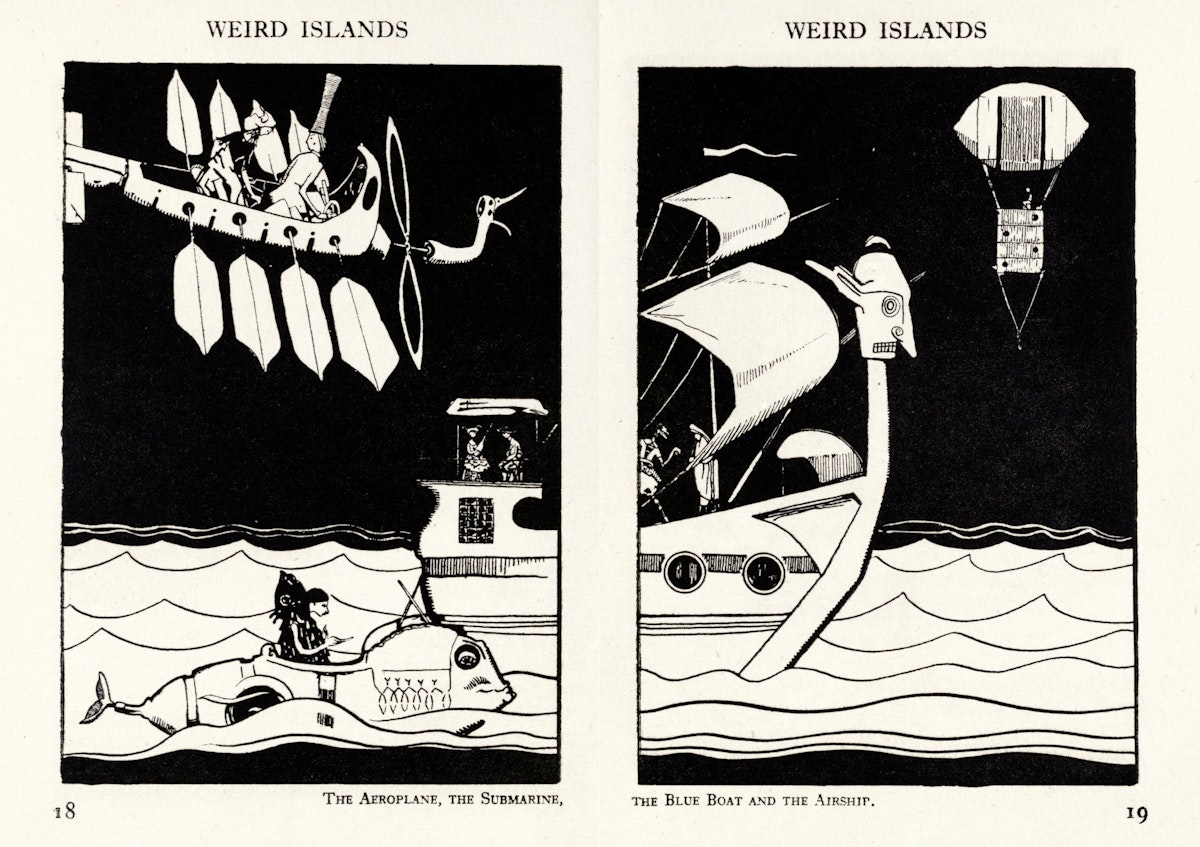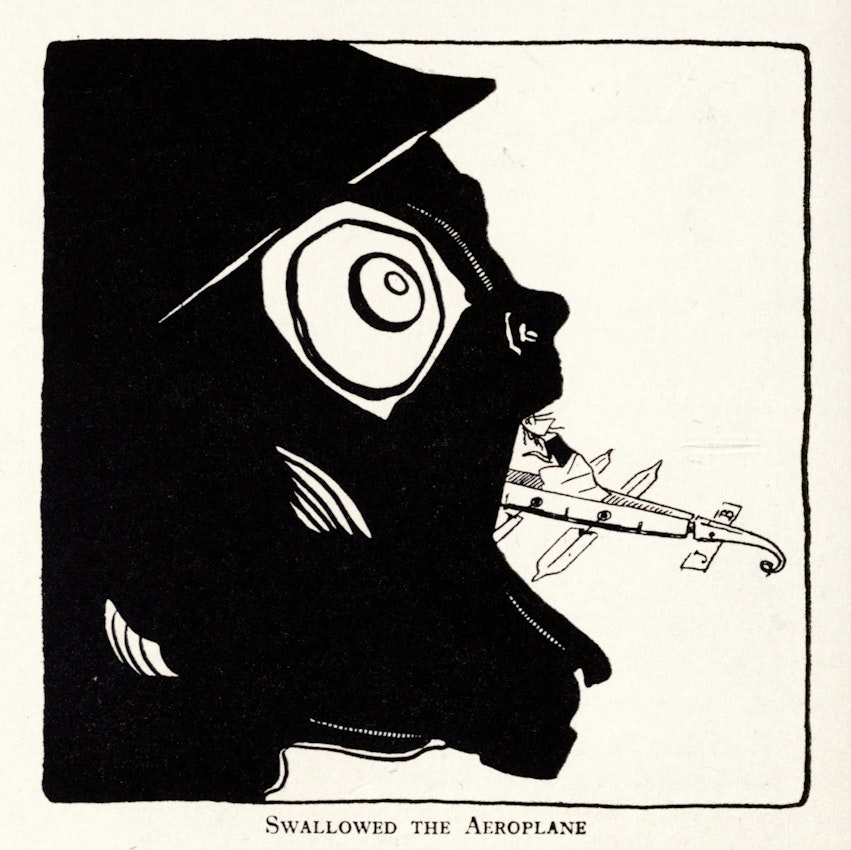
Distortions and Grimaces: Jean de Bosschère’s Weird Islands (1921)
One wonders how many children might have tugged at a parent’s coattails to cajole a present of Jean de Bosschère’s Weird Islands when it was first released in 1921. A glance at any one of its 120 illustrations, all done by the author himself, would surely have scared off all but the most intrepid young readers. The Carpenter — an unnaturally tall, blue top-hatted, androgynous character in yellow bell-bottoms with a folding, insect-shaped airplane strapped to his back — joins a motley troupe of nine musicians (including Bing, taller still than the Carpenter, his face covered by a hawkish black harlequin mask; Peter, a fly-voiced fiddle player with spidery fingers; and Melinda, a selfish girl oblivious to everything and everyone but her own whims) for an outing upon the Thames in their Blue Boat.
Uniformly incompetent and absent-minded, all have crooked postures, slightly misshapen limbs, faces like porcelain dolls, absurd arabesque costumes, and an air of vaporous unreality. Towing the Shark — a submarine piloted by a fellow dressed as a monstrous cod — and a dirigible christened the Lemon of Gold, the ten adventurers set off from Greenwich Pier while making a din with their incongruous instruments, and by the time they have reached the river’s mouth, a gale has set both the dirigible and the submarine adrift. The Carpenter must lend his instrument — a musical saw — to cut down the mast. Everyone escapes a watery grave when he then unfolds his airplane and leads the Travelers on a willy-nilly, topsy-turvy trip to a series of islands inhabited by beings even more uncanny and alien than them.
 Scroll through the whole page to download all images before printing.
Scroll through the whole page to download all images before printing.On the Round Island, along with peacocks and pelicans, they meet a fiendish parrot who warns them to beware of the Balligoors and Coomasis who are known to strangle, hang, and behead any hapless shipwrecked mariners. A ferocious lion and a crown of spherical and cuboid birds accost them on another isle. They go on to encounter a pigwing, a kind of guinea pig with diaphanous useless wings; a crowd of cyclopes who wish to cage them; the Galipodes — storks with little hats made of pastry dough; and atavistic silhouetted creatures with masks of dried leaves. Both de Bosschère’s ten travelers and the archipelago dwellers are relentlessly chimerical and asymmetrical as rendered by his hand. One feels a slight frisson of gooseflesh with every encounter.
Growing up together in the small village of Lier in the desolate Campine moorland of the Low Countries — isolated by having arrived to this Flemish-speaking, intensely pious area as a French-speaking family headed by a free-thinking atheist physician and naturalist — Jean and his beloved sister Marie, who suffered from a cleft lip, were bullied and ostracized. Long before Marie starved herself to death at the age of eighteen, Jean (who recalls making his first drawings at age three) shrank back from the world’s avarice, cruelty, and insensitivity. Even in his most tender and innocent literary and artistic productions — he wrote and illustrated half a dozen other children’s books, and, in the last decades of his life, four exquisite works of natural history — he is “the enraged one”, his inner rebellion perennially erupting to diagnose society’s malaise of soul.
 Scroll through the whole page to download all images before printing.
Scroll through the whole page to download all images before printing.In January 1915, six months after the German invasion of Belgium, de Bosschère fled Brussels for London, carrying with him a notebook filled with sketches in which both the invaders and the invaded were marked by such unsettling dark distortions and grimaces that British censors confiscated them. Like his first books of poetic prose, his early works in English — Twelve Occupations (1916); The Closed Door (1917); The City Curious (1920) — contain their own unsettling sketches, engravings, and woodblock prints. While London appears less grotesquely sinister and threatening than Paris, he still manages to find its most anguished, tormented places; even his fairy tales cannot escape an unrelenting probing of ugliness and despair.
For all his misanthropic severity, de Bosschère was the fiercest of friends. In Paris, he was an intimate of Antonin Artaud, Paul Valéry, Paul Claudel, and André Suarès; in London, he counted Ezra Pound, T. H. Huxley, D. H. Lawrence, Conrad Aiken, and T. S. Eliot among his circle. Recognized by all who knew him as a genius, the reader of any of his works must summon a certain courage to meet his strikingly sensitive gaze at the spectacle of life. Despite its grotesqueries, Weird Islands actually makes for a gentle and humane place to begin.
You can browse a selection of Jean de Bosschère’s illustrations for Weird Islands below.
Apr 9, 2024









